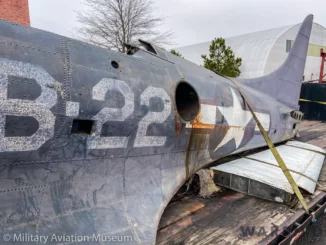
In early 2021, the Military Aviation Museum (MAM) announced the acquisition of Douglas SBD-5 Dauntless Bu.36175 from the National Naval Aviation Museum, along with a substantial collection of related parts from collector and restorer Kevin R. Smith. The restoration was divided between two specialists: Aero Trader in Chino, California, which took on the task of rebuilding the outer wing panels, and Pioneer Aero Ltd in Ardmore, New Zealand, which handled the rest of the work.
VAN Editor Richard Mallory Allnutt, serving as MAM’s Curator of Digital Media, has been closely documenting the restoration’s progress on the museum’s restoration blog. The latest updates focus on the SBD’s wing center section, the right-hand inboard leading edge structure, and various internal fuselage components. To follow this restoration directly from the source, click the image below or click HERE.
SBD-5 Dauntless BuNo.36175 History:
The U.S. Navy first accepted BuNo.36175 for service on October 4th, 1943, but given the type’s impending frontline obsolescence, the Dauntless quickly found herself in a training role guiding young naval aviators in the art of carrier operations from the relative safety of the Great Lakes. But her service life was brief indeed.
According to MAM’s press release: “[On January 20th, 1944,] Lieutenant Charles L. Ford III was attempting a landing on the training carrier USS Wolverine. He was too slow on his approach and was given “come on” signals by the Landing Signals Officer; when he was issued a subsequent “wave-off” command, the pilot banked away from the carrier with too little power, leading to a crash. According to the Navy accident report, the airplane hit the water at a near vertical angle on its back. The pilot was lucky to survive with just a few deep cuts to his forehead.”

With her engine ripped away and wing leading edges crumpled, what remained of the Dauntless soon sank beneath Lake Michigan’s waves to rest in the mud 177 feet down. And there she sat for the next fifty years until A&T Recovery raised her wreck in 1994, similarly to the several dozen other submerged naval aircraft they’ve raised from the Great Lakes and elsewhere. Indeed, A&T Recovery has almost single-handedly ensured the relatively widespread preservation of what had previously been exceedingly rare WWII naval aircraft types, some of which are unique to their breed.
With such a short operational life and no combat record, BuNo.36175 sat in storage for 25 years at the Naval Aviation Museum in Pensacola, becoming a Christmas tree of sorts to provide much-needed parts to repair/restore other more storied examples of the breed. In the process, she lost her outer wing panels, engine section and a number of other components, so what remains today consists mostly of the fuselage, from the firewall back, and the tail feathers. Interestingly, with a little sleuthing, MAM was able to determine that the aircraft’s set of outer wings, once sacrificed for another project, is the same pair under restoration for the project at Aero Trader in California!
A lot has happened with the SBD’s restoration since its arrival with Pioneer Aero in New Zealand. We look forwards to reporting more details in the coming weeks!
To support the Military Aviation Museum and its mission, please visit www.militaryaviationmuseum.org. Furthermore, those interested in receiving the Military Aviation Museum’s monthly restoration update newsletter can sign up HERE.
Related Articles
Richard Mallory Allnutt's aviation passion ignited at the 1974 Farnborough Airshow. Raised in 1970s Britain, he was immersed in WWII aviation lore. Moving to Washington DC, he frequented the Smithsonian’s National Air & Space Museum, meeting aviation legends.
After grad school, Richard worked for Lockheed-Martin but stayed devoted to aviation, volunteering at museums and honing his photography skills. In 2013, he became the founding editor of Warbirds News, now Vintage Aviation News. With around 800 articles written, he focuses on supporting grassroots aviation groups.
Richard values the connections made in the aviation community and is proud to help grow Vintage Aviation News.







See, this is what too many folks do not understand about aircraft “maintenance”. Restoration is not explicitly defined in the FARs, but when the aircraft is 100% disassembled, numerous or even a significant number of replacement parts are fabricated from scratch with the help of blueprints, and then the aircraft is reassembled using major jigs, that is not “restoration”; it is that other thing that you mentioned. “Rebuilding.” But the regs also say that only the OEM is authorized to rebuild an aircraft. That means that when these folks are done, technically speaking “Douglas” will no longer be it’s actual builder and the Douglas data tag will no longer be valid. It should henceforth be identified as an “Aero Trader” (or whoever) SBD Dauntless because “rebuilding” is not a Part 43 maintenance operation; it is a Part 21 manufacturing operation.